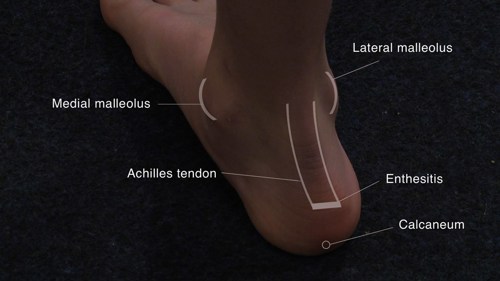Causes of Foot, Heel and Ankle Pain
In the absence of trauma, skin or nail infection (e.g., ingrown toenail or verrucae / warts), conditions to consider include:
Tarsal Coalition: abnormal tarsal bone development and can be bilateral; caused by a cartilaginous/fibrous bar between calcaneum and navicular bones or talus and calcaneal joints. Unless there is ossification, the abnormality can be missed on radiograph. The clinical presentation is pain and non-flexible flat feet. Typically presents in adolescents with a history of 'ankle sprains'. Management is orthotics, analgesia and in extreme cases, surgery is required. A pitfall is to miss inflammatory arthritis (often Enthesitis Related Arthritis) that can present with a painful stiff mid foot.
The MRI below shows gadolinium enhancement due to synovitis in the ankle and mid-tarsal joints (arrows) in Juvenile Idiopathic Arthritis

Inflammatory Arthritis: this can an affect any joint in the ankle or foot with inflammatory symptoms and signs (swelling or restricted mid-foot). Inflammatory arthritis (Enthesitis Related Arthritis) needs to be considered; enthesitis is very localised pain over an enthesis (e.g., the tendon insertion of the Achilles tendon into the calcaneum - see the photograph below). Juvenile Idiopathic Arthritis can also involve small joints of the foot / feet and can be bilateral - asymmetry or single toe involvement is more typical of psoriatic arthritis (dactylitis). Infection or reactive arthritis, including rheumatic fever need to be excluded with single joint involvement.
Pes Cavus: ‘high arches’ with persistent tip toe gait which may be asymptomatic or present with pain or clumsy walking. Need to consider neurological and neuromuscular abnormalities (e.g., Spina Bifida, Friedreich’s Ataxia) or metabolic storage diseases (e.g., mucopolysaccharidoses).
Rocker bottom Feet (congenital vertical talus): usually detected in newborn and can be associated with neurological problems. Surgery is often needed.
Congenital Talipes EquinoVarus (clubfoot): usually detected in newborn (foot held pointing down and in a varus position); may be a positional deformity (oligohydramnios in pregnancy) and may resolve with casting and physiotherapy. Surgery is needed with structural abnormality.
Achilles tendonitis: typically an overuse injury and can be compounded by unsupportive footwear. Tends to be in older children with pain on activity, especially jumping. Management is through advice on footwear, modifying activity, analgesia and in the acute phase Rest, Ice, Compress, Elevate (RICE). Stretching exercises and orthoses (gel heel cup) may help.
Sever’s disease: an osteochondritis (similar to Osgood Schlatter's disease at the knee) with pain at the insertion of Achilles tendon into the calcaneum. Typically occurs as a result of rapid growth and / or excessive activity, in older children with pain increasing with activity. Management is RICE, modifying activity and analgesia. Stretching exercises and orthoses (gel heel cup) may help. This has to be distinguished from enthesitis as a feature of enthesitis related arthritis and any suggestion of inflammatory joint disease warrants referral.
The photograph below shows surface anatomy and sites for tenderness (Enthesitis) and over the calcaneum (Sever's disease)

Plantar fasciitis: (inflammation of plantar fascia) presents with heel pain, worse with increased activity, or initial weight bearing after rest and may be more common in overweight children. Inflammatory arthritis (Enthesitis Related Arthritis) needs to be considered. Enthesitis is very localised pain over the enthesis. Management is RICE, modifying activity and analgesia. Stretching exercises and orthoses (gel heel cup) may help.
Kohler's disease: an osteochondrosis of the navicular bone. Typically in young school aged children with midfoot pain and swelling. Can be bilateral. Inflammatory arthritis (Enthesitis Related Arthritis) needs to be considered. Radiographs show increased sclerosis of navicular bone. Management is RICE, modifying activity and analgesia.
Freiberg’s disease: osteonecrosis of second or third metatarsal head with forefoot pain and local tenderness. Typically in adolescent girls. Management is RICE, modifying activity, supportive footwear, analgesia and surgery in extreme cases.
Malignancy: rare but does occur. Look out for red flag symptoms. Benign bone tumours (e.g., osteoid osteomas) or malignant tumours (calcaneum is a common site).
Chronic infections: such as Tuberculosis (TB) can present with foot and ankle pain and swelling
Growing pains: these commonly cause foot and ankle pain - often associated with hypermobility and mobile flat feet but be aware of the rules so as not to miss pathology.

